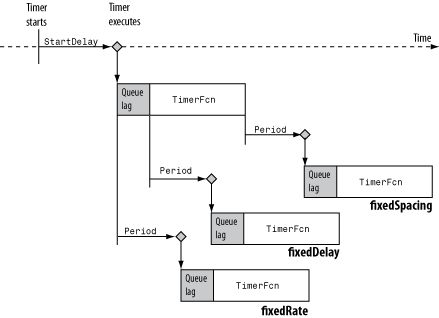timerfind
Class: timer
Find timer object
Description
out = timerfindout.
out = timerfind(Name,Value)Name,Value pair arguments and returns an array,
out.
out = timerfind(t,Name,Value)Name,Value pair arguments to the timer objects listed
in t, where t can be an array of timer
objects, and returns an array, out.
Input Arguments
|
Array of objects of class |
|
Structure with field names corresponding to |
Name-Value Pair Arguments
Specify optional
comma-separated pairs of Name,Value arguments. Name is
the argument name and Value is the corresponding value.
Name must appear inside quotes. You can specify several name and value
pair arguments in any order as
Name1,Value1,...,NameN,ValueN.
|
Character vector or string scalar that indicates action taken when a timer has to execute
See Handling Timer Queuing Conflicts for more information. Default: | ||||||||||||||||
|
Character vector, string scalar, function handle, or cell array defining the function that the
timer executes when an error occurs. If there is an error, this function executes, and then
calls
For more information, see Timer Callback Functions. | ||||||||||||||||
|
Character vector or string scalar that defines how the
Default: | ||||||||||||||||
|
Character vector or string scalar representing the Default: | ||||||||||||||||
|
Character vector or string scalar with possible values of Default: | ||||||||||||||||
|
Number greater than 0.001 that specifies the delay, in seconds,
between executions of Default: 1.0 | ||||||||||||||||
|
Number greater than or equal to 0 that specifies the delay,
in seconds, between the start of the timer and the first execution
of the function specified in Default: 0 | ||||||||||||||||
|
Character vector, string scalar, function handle, or cell array defining the function that executes when the timer starts.
For more information, see Timer Callback Functions. | ||||||||||||||||
|
Character vector, string scalar, function handle, or cell array defining the function that executes when the timer stops.
For more information, see Timer Callback Functions. The timer stops when
You can use | ||||||||||||||||
|
Character vector or string scalar that represents a label for the object. | ||||||||||||||||
|
Number greater than 0, indicating the number of times the timer
object is to execute the Default: | ||||||||||||||||
|
Character vector, string scalar, function handle, or cell array defining the timer callback function. You must define this property before you can start the timer.
For more information, see Timer Callback Functions. | ||||||||||||||||
|
Generic field for data that you want to add to the object. |
Read Only Name-Value Pair Arguments
|
Average time in seconds between |
|
The time in seconds between the last
two executions of |
|
Character vector defined as |
|
The number of times the timer called |
|
Character vector that identifies the object type. |
Examples
More About
Tips
timerfindonly finds visible timer objects. Visible timer objects are those that are in memory and have theObjectVisibilityproperty set to'on'. To find objects that are hidden, but still valid, usetimerfindall.
See Also
delete | timer | timerfindall

